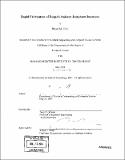Rapid fabrication of deep-submicron Josephson junctions
Author(s)
Cord, Bryan M. (Bryan Michael), 1980-
DownloadFull printable version (5.118Mb)
Other Contributors
Massachusetts Institute of Technology. Dept. of Electrical Engineering and Computer Science.
Advisor
Terry P. Orlando.
Terms of use
Metadata
Show full item recordAbstract
A process was designed to fabricate Nb-AlOx-Nb Josephson junctions for quantum computing applications, with the goal of fabricating junctions as small as 0.2 [micro]m in diameter in a time span of roughly two weeks. The process was based on the doubly-planarized all-refractory technology for superconductive circuits (DPARTS) process currently used to fabricate these devices at MIT Lincoln Laboratory and streamlined by removing or replacing the most time-consuming steps and several optical layers. In addition, 248-nm (deep-UV) photolithography was employed for the first time in a Nb-based process, with the goal of improving resolution past that achievable by standard i-line lithography. The process has five optical layers, two wiring layers, and a via layer, and is intended to be used for rapid-turnaround evaluation of simple circuits requiring only two wiring layers. Anodization was used to produce a 50 nm film of NbOx to isolate the wiring layers, replacing the time-consuming oxide deposition and planarization used in the DPARTS process. A novel metallization and liftoff process employing surface-poisoning of chemically-amplified resist was used to deposit the contact layer. Several new plasma etching techniques were developed to selectively etch the various materials present in the process as well. The full process flow is briefly described in order of fabrication, followed by a detailed discussion of major process steps, issues, and results. Finally, testing results from devices fabricated using the new process are presented. An appendix detailing the design-of-experiment (DOE) approach used to characterize several process tools is also provided.
Description
Thesis (S.M.)--Massachusetts Institute of Technology, Dept. of Electrical Engineering and Computer Science, 2004. Includes bibliographical references (p. 113-116).
Date issued
2004Department
Massachusetts Institute of Technology. Department of Electrical Engineering and Computer SciencePublisher
Massachusetts Institute of Technology
Keywords
Electrical Engineering and Computer Science.